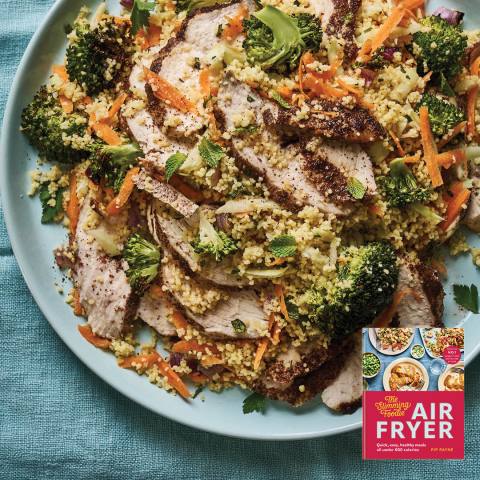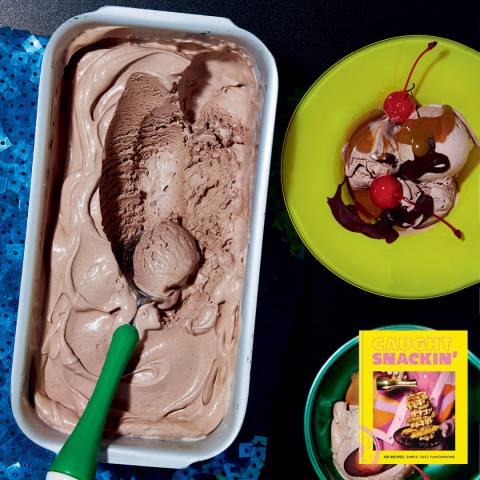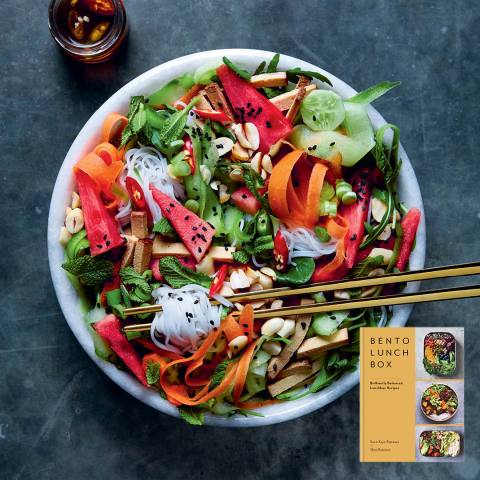RASPBERRY AND ROSE GIN MILLE FEUILLE
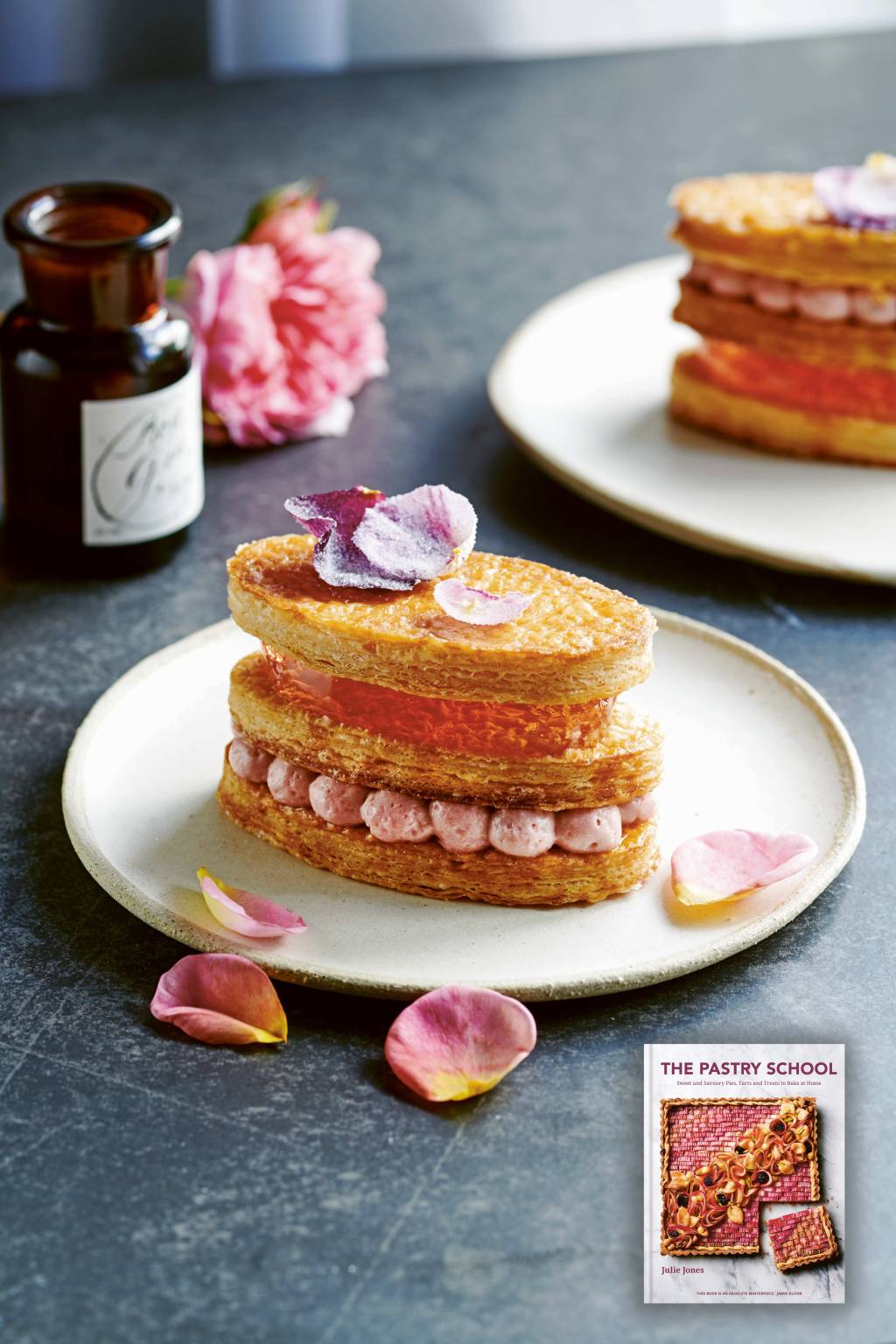
I first came across Tinkture Rose Gin through Instagram. A foodie friend recommended it and so I tried. I was blown away by the delicate floral flavour, the rose-pink colour change when the mixer was added, the carefully designed packaging and the thoughtful ethos that was behind the production. I am a huge fan, and now Hannah, the lady behind the brand, and I are friends. To honour this new-found friendship and to celebrate this magnificent gin, I have created a recipe that will partner perfectly with a rose gin cocktail to make a special end to a celebratory meal. This dessert does take time, so a bit of forward planning is needed – in particular, the jelly requires overnight setting. You could also make, roll and cut the pastry in advance, ready to be baked on the day. There will be leftover jelly and mousse, as it is difficult to make both on a smaller scale. However, both can be eaten separately later – perhaps with a bowl of fruit. Slurping on leftover gin jelly will never be a sad thing, but do remember that it is extremely boozy!
FOR THE PASTRY
Inverted puff pastry isn’t something you’d expect to see in a baking book aimed at the home cook. In fact,
on researching it I often read that the challenge of making this pastry far outweighs its benefits. I disagree completely, and believe that if standard puff pastry can be made successfully at home, the inverted version can be, too. Is it worth the effort? Absolutely! The crunch you get from the finished pastry is just wonderful. Of course, there are some complications. With the butter being the outer encasing layer, hot hands will never make for a straightforward and easy task, but fret not, my tips and techniques will help even the most hot-handed bakers achieve those wonderfully crisp layers.
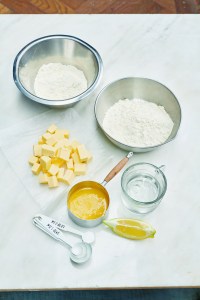
MAKES 1 QUANTITY
Suitable for both sweet and savoury bakes
For the encasing butter layer
180g (6¹⁄³oz/¾ cup plus 2 teaspoons)
unsalted butter, very cold and cut into
1cm (½in) cubes
80g (2¾oz/½ cup plus 1 tablespoon) strong white bread flour
For the dough layer
150g (5¼oz/1 cup) strong white bread flour, plus extra for dusting
½ teaspoon fine salt
45g (1½oz/3 tablespoons) unsalted butter, melted and cooled
juice of ¼ lemon
80g (2¾oz) strained iced water
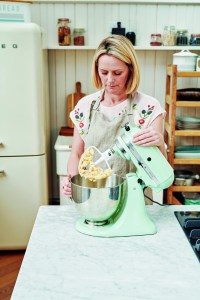
To make the butter layer, place the cold cubed butter and the flour into the bowl of a freestanding mixer fitted with the paddle attachment. Mix on a m
edium speed for 1 minute, or until the two ingredients have combined. What you want is a stiff, buttery paste, so do be careful not to overwork it. Lay out a large sheet of non-stick baking paper and place the paste on it. Cover with a second sheet and use a rolling pin and a sturdy ruler to flatten and manipulate the butter into a rectangle measuring around 30 x 20cm (12 x 8in). Keep the butter in between the sheets of baking paper and place in the fridge for a minimum of 10 minutes, while preparing the next stage.
Place all of the dough layer ingredients into a large bowl – and bring together using a fork. When well combined, roll out on a lightly floured work surface into a rectangle half the length and just short of the width of the butter layer – approximately 15 x 18cm (6 x 7in). Remove the butter layer from the fridge and position it so that a shorter side is closest to you. Lay the dough rectangle over the bottom half, then fold the exposed butter downwards, using the paper underneath to help you. Peel back the paper, leaving the butter in place, and seal the three edges by nipping the top and bottom layers together. If your hands are hot, I would recommend plunging them into a bowl of iced water for a few minutes before touching the butter. Wrap the pastry loosely in the paper and then in cling film and place in the fridge for 30 minutes.
Lay out a sheet of non-stick baking paper and give it a very light dusting of flour. Unwrap the pastry (keep the wrapping) and place it on the paper, dusting with more flour. Gently press a rolling pin into the pastry, across both width and length, this will help make the butter malleable.
The pastry is now ready to roll and fold. To do this successfully always roll on lightly floured non-stick baking paper and roll only using an upwards and downwards motion with a shorter edge always nearest you. There is no harm in turning the pastry over and switching
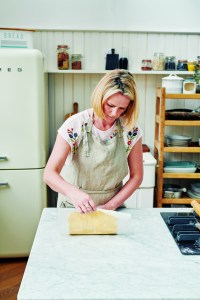
top to bottom when doing this, as long as a short edge faces you throughout.
Roll out to the original rectangle of approximately 30 x 20cm (12 x 8in). If during rolling you feel that the butter is softening too much, simply return it to the fridge for 5 minutes on the paper, then try again. Use a sturdy ruler to shunt the edges into neat lines. The pastry is now ready for the first fold.
To do this, bring the top half down to the two-thirds point (10), then bring the bottom third up and over it, trying to keep the edges neat and in line with each other. Again, use the rule
r to shunt it into position. Re-wrap in the saved baking paper and cling film and use a marker pen to write ‘x1’, referring to the single fold, and the time. Rest in the fridge for, at the very least, 1 hour.
Remove from the fridge (keeping the wrappings) and place on a piece of lightly floured non-stick baking paper. If the pastry has been in the fridge for longer than 1 hour, allow to stand at room temperature for 10–15 minutes, or if the kitchen is very hot, reduce the time accordingly. Gently press the pastry as previously instructed in image 8, then position itso that one of the shortest sides is closest to you. Roll out as before, in an upwards and downwards motion, back to approximately 30 x 20cm (12 x 8in). Use a double fold this time, keeping all the edges neat and in line. Re-wrap and add ‘x2’, referring to the double fold, and the time, below your previous marking. Leave to rest in the fridge for at least 1 hour.
Repeat one more single and one more double fold in that order, resting for a minimum of 1 hour between each, and then a final hour after the last fold. The pastry is now ready to be rolled out and baked according to the relevant recipe instructions. Do remember, if the folded pastry has been in the fridge for longer than an hour, leave it to stand at room temperature for up to 15 minutes, and use the pressing technique as in image 8 before rolling. It is also important to roll gently and rest occasionally, both to maintain the layers and prevent springback.
FOR THE MILLE FEUILLE
MAKES 6
1 quantity Inverted Puff pastry
plain (all-purpose) flour, for dusting
icing (powdered) sugar, for baking
For the jelly
5 sheets gelatine (I use Dr Oetker)
150ml (5fl oz/²⁄³ cup) pear cordial, mixed with 350ml (12¼fl oz/1½ cups) water
250g (8¾oz/1¼ cups) caster (superfine) sugar
250ml (8½fl oz/1 cup plus 1 tablespoon) Tinkture Rose Gin
For the raspberry mousse
3 sheets gelatine
200g (7oz/2 cups) fresh or frozen raspberries, thawed if frozen
25g (¾oz/2¾ tablespoons) icing (powdered) sugar, plus extra for dusting
2 eggs, separated
40g (1½oz/3¼ tablespoons) caster (superfine) sugar
300ml (10½fl oz/1¼ cups) double (heavy) cream
30ml (1fl oz/2 tablespoons) pear cordial
To decorate
crystallized rose petals (optional)
Roll the pastry between two sheets of baking paper to approximately 5mm (¼in). If, however, the pastry has been made in advance, please see the notes on page 19 prior to rolling.
The secret to achieving consistent, perfectly baked pastry ovals is rolling them all to the exact same thickness. To do this, I roll the cut pastry through a pasta machine – set to the widest setting. The pastry does have to be chilled yet pliable to do this, so as not to disrupt the buttery layers created during the folding process, so please do this with caution, or even leave out this stage if you are not too fussed about variations during baking.
First roll the pastry between the baking paper to 5mm (¼in) using a rolling pin, then, if wanting to roll through a pasta machine, cut into long, wide strips and pass through the machine, on the widest setting. Cut 18 ovals using a cutter measuring 8.5cm x 5.5cm (3½in x 2¼in), then rest in the fridge for at least 30 minutes, covering with cling film to prevent drying.
Preheat the oven to 180ºC (350ºF), Gas Mark 4. Depending on how many flat baking sheets are to hand, the baking of the pastry may need to be done in stages. Sift some icing (powdered) sugar onto a work surface and lay the cut pastry shapes onto it, coating one side completely. Transfer to a flat baking sheet lined with non-stick baking paper, leaving a gap between each. Top with another sheet of non-stick baking paper and lay another baking sheet on top. Place in the oven and bake for 20 minutes, after which time the pastry should be crisp and deep golden, the icing (powdered) sugar caramelized and crisp. Transfer to a wire rack and repeat until all of the pastry pieces have been baked. Allow to cool completely and then store in an airtight container until ready to assemble the desserts.
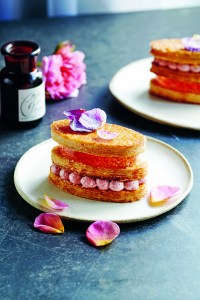
Line a 3cm (1¼in) deep baking tray that measures 30cm x 22cm (12in x 8½in) with cling film.
To make the jelly, first soak the gelatine in cold water and set to one side until softened. Make up the cordial and place it in a saucepan with the caster (superfine) sugar. Gently heat until the sugar dissolves, then add the gin.
Remove from the heat, drain the softened gelatine and pat dry with some kitchen paper, then add to the hot gin mixture and stir until dissolved. Pour the liquid through a sieve into the pre-lined baking tray, allow to cool, then transfer to the fridge to fully set – due to the alcohol content, this should be done overnight.
For the mousse, soak the gelatine in cold water to soften. Meanwhile, blitz the raspberries in a food processor, along with the icing (powdered) sugar. Pass the fruit through a sieve, discarding the pips. Place the egg yolks in a bowl with the caster (superfine) sugar and whisk (by hand or machine) until thickened, lightened in colour and increased in volume, which should take a good 5 minutes, or longer if whisking by hand.
In a clean bowl, whisk the egg whites until white and frothy. Whip the cream to soft peaks in another bowl. Drain the softened gelatine and pat dry with some kitchen paper, then place in a small saucepan with the pear cordial and very gently heat until the gelatine dissolves. Pour the liquified gelatine into the raspberry purée and add this to the whisked egg yolks. Add one-third of the egg whites and stir in – no need to be gentle. When combined, add the remaining egg whites and the whipped cream and now gently fold everything together, preventing the egg whites from deflating and the cream from stiffening. Transfer to a piping bag fitted with a 1cm (½in) plain piping nozzle and put in the fridge. The mousse will be perfectly set after 1½ hours but can still be piped after that time, too.
Take both the set jelly and mousse from the fridge. Pipe some raspberry mousse onto six of the pastry ovals. Using the same cutter that was used for the pastry, cut six pieces of jelly (freezing for 30 minutes prior to cutting will help). Top the remaining ovals with the jelly and use those to top the mousse. Top with the last pastry ovals and decorate with some crystallized rose petals, if using. If preferred, mix and match the way in which these desserts are assembled.
Serve immediately.
This recipe is from The Pastry School by Julie Jones. If you liked this recipe, why not try Julie’s chamomile panna cotta?

